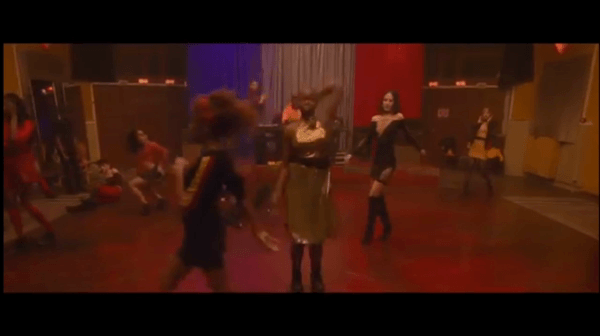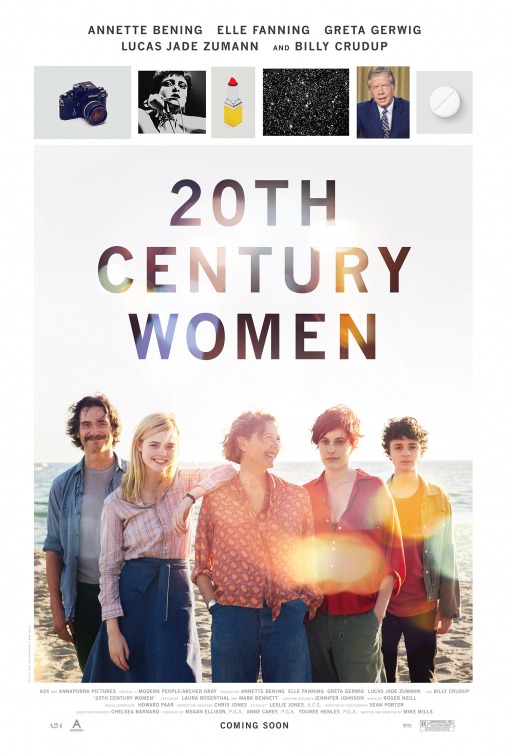
|

|
|

|
20th Century Women
a Mike Mills film
Plot (Spoiler Alert)In 1979, in Santa Barbara, California, a mother, Dorothea, has two other women of different ages, Julie and Abbie, help raise her son, Jamie. 
Blaine: These characters in “20th Century Women” are based off of real people in writer/director Mike Mills’ life. Dorothea is supposed to be Mike’s mom, Julie is a combination of girls he had crushes on when he was very young and Abbie is Mike’s sister. Mike felt like he was raised by his mom and sister growing up so he has always appealed to women in his world. He always leaned to them to figure out his life and he felt that would be a good idea for a film. There’s times it makes you laugh and there are lines in it that is so original that hasn’t been done yet like Julie’s line “Don’t you need a man to raise a man?” They said the music has a key role in the film and it was a huge part in the script. Mike said that it is a huge part of the culture in each character and they had these dance parties every morning as a rehearsal and Annette Bening didn’t want to do it, but Greta Gerwig has always loved dancing since she was a kid and she has danced in some of her other projects and when she would take off during rehearsal listening to David Bowie. One of the things “20th Century Women” shows me is a different side to the 1970s that I’ve never seen before in a film with the punk music of that time. Dorothea had Jamie in 1964 an she was 40 at the time. She and her husband have been divorced for some time and she is trying to understand her son more, but she can’t read him. She has Julie and Abbie help her raise Jamie because he is close with them. What Julie and Abbie are teaching Jamie is the nature of women and sexual activity and Dorothea believes the sexual stuff is too far even though he’s at a right age. And also Julie does therapy, which she takes after her mom even though the aren’t that close and Abbie is in charge of telling Jamie about her life. Mike would allow his actors to do their performances free will, but they also had to study a lot of things as well in order to explore these characters they play. Annette Bening grew up in San Diego and she was nineteen in ’79 and when she read the script for “20th Century Women” it was different compared to what she grew up in that time period and she grew fascinated with what was in the script. And like me, there were parts of it that she thought was smart and hadn't been done yet in a film. Because Dorothea is based on Mike Mills’ mom it was a mystery for Annette Bening to play someone who is not a famous historical figure who she could learn through old footage, but she and Mike developed the character together. Mike had shown pictures and described his mom to Annette and what ever Annette found interesting should keep for her performance and the rest she would use at all. She would also watch the films Mike Mills’ mom loved to watch. From the looks of it, Dorothea doesn’t understand or respond to the surroundings of 1979 as much as the time she grew up in, for example the music she goes for is Louis Armstrong, Sandy Williams, Fred Astaire and Rudy Vallee. Mike Mills had gone to art school and he said conceptual art is a big part of his life and it felt normal for him to have old still photos from the 1920s and 30s in the film because they also teach us history, in his opinion. A lot of Elle Fanning’s character, Julie, came from the friends Mike interviewed who were the same age as the character back in 79. Like when she is talking about her first period, that came from one of Mike’s great friends and losing her virginity came from another. Sometimes actors can express the character through the clothes they wear in the film and Elle said the costume fittings really helped and she described Julie as someone having intellectual side like a young Jodie Foster, very smart, hides the wildness within her well and sort of a slut. Mike had a girlfriend once whose mom was a therapist and they would go to group therapy and that’s how he started off the Julie character. Mike gave Elle a 1970s book to read about psychiatry and therapy of love called “The Roadless Travel” and she would have to pick out anything that sounded interesting to her or her character and she would have to explain in her own words to Mike what she read in a chapter. Julie talks about love and marriage in the film and when it came to those scenes Mike would tell Elle to do her “Roadless Travel” thing. The performance I like the most is Greta Gerwig as Abbie and I think this is by far her best performance because I was seeing a completely new person out of her. Abbie is someone who likes to hang out at clubs, has a career in photography, wants to be a mom in life, but she can’t because she has cervical cancer and she channels her depression through music and dancing. Greta Gerwig knew she wanted to be a part of the project before she read the script because she had been wanting to work with Mike Mills after seeing his work from the past. Abbie is based off of Mike Mills’ sister and Greta would get in touch with her and she would tell Greta about her life in the ‘70s, New York, Santa Barbara and her relationship with her mother. Greta didn’t feel obligated to play Mike’s sister because he gave the actors freedom to find these characters through their performances, but Greta said it was the connection to this real person that was helpful. In Greta Gerwig’s past films she always had blonde hair because people liked it better that way when really she has been wanting to transform into someone who looks different compared to that and Greta was happy to have a new hairdo for “20th Century Women”. Manic Panic hair dye was created in 1978 and Mike wanted the exact product that they would have had at the time so Greta would use it on her hair every day. Greta Gerwig would have homework assignments given by Mike Mills of punk music of 1979 and how to learn to use an old camera. She also had to read books on photography and art and also a lot of art criticism and feminist essays. Greta had to push herself to know she could do this job after she got the part because it was an entirely different project for her and she is grateful that Mike believed in her and while they were shooting, she explored a new side to her as an actor. I like the expressions Greta shows on her face as Abbie compared to her other movies. Greta said that Abbie was a hard character to let go after playing her because she loved her so much and she learned stuff while exploring the character. This is Lucas Jade Zumann’s first film and in a way working with other actors is like teaching him how to be an actor just like these characters are teaching Jamie in the film. Lucas would have reading assignments of books Mike gave him and watch these documentaries on the 70s. He also read the cultural dictionary of punk which he found super helpful because he can understand the struggles that come with being a teenager, being one himself, but he still didn’t identify the more destructive side of punk as much as he wanted to. In the end the characters talk about what happens to them in the future and it was sort of sad for me at first because they go their separate ways and these characters are close and I love seeing them together. Dorothea dies of lung cancer twenty years later, Jamie gets married and has a child, Julie gets married as well, but doesn’t want children and the good news for Abbie is she has two children. My rating on “20th Century Women” is five out of five stars. |